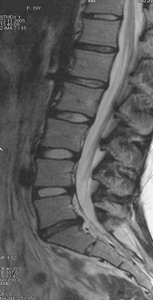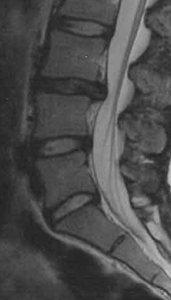Study finds increased low back pain, MRI findings as children age
GOTHENBURG, Sweden — A prospective long-term study that followed healthy school age children through maturity showed 59% of them had low back pain by the time they reached 18 to 19 years old, with 9% having reported experiencing low back pain at the outset of the investigation, when they were 7 to 8 years old.
At about age 19 years, 15% of those studied had black discs on MRI, according to investigators at ORTON Orthopaedic Hospital and ORTON Research Foundation, in Helsinki, who won the Medtronic award for the best clinical paper at the International Society for the Study of the Lumbar Spine Annual Meeting 2011.
Teija Lund, MD, PhD, said she and her colleagues tried to define the starting point of MRI changes by studying 95 healthy first-grade students in the Helsinki area (51 girls, 44 boys), an idea originated by Prof. Dietrich Schlenzka, head of the spine department, ORTON Orthopaedic Hospital.
|
|
|
|
Investigators assessed sagittal T2-weighted MR images for nucleus signal intensity, disc height, protrusions, herniations, anular tears, or high intensity zones. They graded nucleus signal intensity visually as bright, speckled (a), or black. More severe MRI changes such as herniations (b), were rare in these age groups. Images: Lund T |
|
“MRI findings in the lumbar spine can be seen already at early school age. There’s a significant increase in both MRI findings and low back pain (LBP) during the growth spurt, but we couldn’t find any correlation between MRI findings and low back pain and no predictive factors,” she said.
In addition to evaluation at ages 7 to 8 years, and again at 18 to 19 years old, the children studied were evaluated once when they were 12 to 13 years old. Lund reported a 92% follow up rate at the last time point they were evaluated.
Follow-ups involved a structured interview, clinical examination and a T2-weighted sagittal MRI. “At the first time point we also took one lateral X-ray of the lumbar spine,” Lund said.
“By the age of 18 and 19, 15% of young adults demonstrated black discs and the rate of other MRI findings had increased to almost 60%, and not unexpectedly most of these changes were at the two lowest lumbar levels,” she said.
Though no clear predictive factors emerged, researchers noted a slightly greater LBP frequency with more MRI changes in young women vs. young men and 18- to 19-year-old smokers vs. non-smokers.
The investigators observed a greater prevalence of MRI changes in girls when they were undergoing a growth spurt but not when it ended, according to the results.
“Epidemiological research has shown LBP in children and especially adolescents is much more common than previously thought. In our study, the frequency of low back pain increased markedly during the growth spurt. However, in only 14% of our young adults the symptoms were severe enough to warrant medical consultation. Moreover, although the frequency of MRI changes increased during the growth spurt, there was no correlation between these changes and LBP. In the future, clinicians will probably see increasing numbers of young patients with LBP. Our attitude should be more towards assuring the patients of the benign nature of their symptoms, and too much emphasis should not be put on the concomitant MRI changes,” Lund told Orthopaedics Today Europe. – by Susan M. Rapp
Reference:
- Lund T, Klemetti E, Lohman M, et al. Lumbar disc changes on MRI and low back pain. A prospective long-term study in healthy volunteers from childhood to maturity. Paper #P20. Presented at the International Society for the Study of the Lumbar Spine Annual Meeting 2011. June 14-18. Gothenburg, Sweden.
- Teija Lund, MD, PhD, can be reached at ORTON Orthopaedic Hospital, Helsinki, Finland; +358-9 474 81; email: teija.lund@invalidisaatio.fi.
- Disclosure: Lund has no relevant financial disclosures.
Lund et al observed a high prevalence of low back pain (LBP) in adolescents and tried to see whether this was linked to MRI findings. The relationship between MRI findings and chronic LBP in adults is still very controversial. Whereas many healthy individuals without LBP present with MRI signs of lumbar disc degeneration, it is also true that LBP sufferers often present with MRI changes indicating disc degeneration. During the last years, a large number of studies in different countries have shown the prevalence of non-specific LBP among adolescents is close to the figures well known for adults. It is not surprising therefore to find lumbar MRI changes similar to what is found in adults. Yet, Lund et al clearly observed that no correlation between MRI findings and LBP had been established in their study. This high incidence of LBP in adolescents begs for deeper understanding. S. Rajasekaran, MD, reported how in India with its 1 billion inhabitants, spine surgeons, until very recently, only dealt with deformity, stenosis and disc herniations or trauma and infections. LBP only appeared as a clinically reported condition when 'westernizing' of the society become more widespread (Rajasekaran, S., LBP: A cultural problem; Brussels International Spine Symposium 2007). There clearly must be factors leading to the manifestation of LBP linked to our lifestyle. In the same way it would be interesting to find out to which extent children who report LBP may have one or both parents complaining of LBP. In a longitudinal study we performed on almost 400 schoolchildren and reported on in 1999, we found there was a significant correlation between self-reported LBP and indicators of general well-being, as well as between self-reported LBP and LBP in these children's parents (Gunzburg et al. Eur Spine J. 1999; 8:439-443.). This has insufficiently been explored. Reporting LBP in children could well be a learned behavior perpetuating the 'condition' from generation to generation and leading to overuse of medical care and the inability to function adequately both professionally and socially. Further study hereof should help us target the younger population group as to the benign character of "common" LBP.
— Robert Gunzburg, MD, PhD
Deputy Editor-in-Chief, European Spine Journal
Cavell Spine Center
Brussels, Belgium
Disclosure: He has no relevant financial disclosures.



